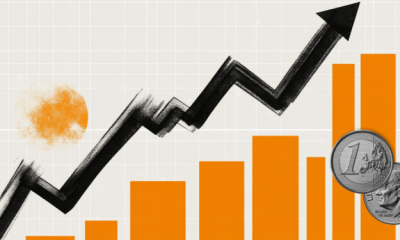

others
Australian Dollar snaps a two-day losing streak ahead of US Consumer Sentiment – Crypto News
- Australian Dollar dipped post-release of the US headline inflation.
- Consumer Inflation Expectations raised the odds of RBA to increase interest rates.
- US Dollar advanced following the slew of upbeat US data.
The Australian Dollar (AUD) snaps a two-day losing streak post a slew of optimistic economic data from the United States (US) during the week. With US inflation surpassing expectations and initial jobless claims coming in lower than anticipated, discussions about the trajectory of the US Federal Reserve’s (Fed) monetary policy have been reignited.
Australia has experienced a rise in consumer expectations regarding inflation, a trend likely influenced by an increase in oil prices. The upcoming focal points include the release of Meeting Minutes from the Reserve Bank of Australia (RBA) and employment data in the next week.
This downbeat Chinese inflation data has the potential to impact the Australian Dollar, considering Australia’s significant role as a major exporter to China. Economic dynamics between these two countries often influence the performance of the Aussie Dollar, and the subdued inflation figures from China may contribute to undermining its strength.
The US Dollar Index (DXY) gained upward momentum after a robust release of US data. Nonetheless, on Friday, the US Dollar (USD) is trading marginally lower, influenced by a retreat in US Treasury yields following a recent surge. Market participants are expected to redirect their attention to the Michigan Consumer Sentiment Index set to be released on Friday.
Investors seem to factor in the possibility of another Fed rate hike. This is noteworthy given the recent mixed rhetoric from most Fed officials, emphasizing the necessity for the US central bank to maintain higher rates for an extended period, even without signaling a clear intention for another rate increase.
Daily Digest Market Movers: Australian Dollar attempts to retrace recent losses on RBA interest rates trajectory
-
Australian Consumer Inflation Expectations for October have been reported at 4.8% on Thursday, showing a slight increase from the September figure of 4.6%.
-
Australia witnessed a rebound in inflation in August, largely driven by elevated oil prices. This resurgence raises the probability of another interest rate hike by the Reserve Bank of Australia (RBA).
-
The unfolding Middle East conflict adds a layer of complexity to the situation, potentially prompting the RBA to implement a 25 basis points (bps) interest rate hike, reaching 4.35% by the year’s end.
-
The heightened geopolitical tension is fostering a surge in demand for commodities, particularly energy and gold. This surge is exerting a positive influence on the performance of the AUD/USD pair.
-
Australia’s Westpac Consumer Confidence showed that current buying conditions improved in October. The index rose 2.9% from the previous 1.5% decline in September.
-
The recent release of the Consumer Price Index (YoY) by the National Bureau of Statistics of China for September brought some notable figures. The reading of 0.0% came in lower than the expected 0.2% increase, compared to the previous reading of 0.1%. Meanwhile, the Producer Price Index year-over-year experienced a decline of 2.5%, surpassing the anticipated decrease of 2.4%.
-
The US Bureau of Labor Statistics (BLS) disclosed that the Consumer Price Index in the US surpassed forecasts in September. The annual basis figures expanded at a consistent rate of 3.7%, slightly exceeding estimates of 3.6%.
-
US Initial Jobless Claims for the week ending on October 6 showed a slight easing, despite an increase of 209K, which was slightly below the forecast of 210K.
-
US Producer Price Index (PPI) surged in September on a yearly basis, jumping from 2.0% to 2.2%, surpassing the anticipated 1.6%. Core PPI experienced a rise, climbing to 2.7% from the anticipated easing to 2.3%, surpassing the earlier figure of 2.5%.
-
The yields on US Treasury bonds advanced on Thursday on the back of solid US data, with the 10-year US Treasury bond yield marking the highest level at 4.72%.
-
The Federal Open Market Committee (FOMC) minutes shed light on a divergence of opinions, underlining the importance of data reliance. The consensus for additional interest rate hikes appears contingent on a significant uptick in inflation.
-
Some participants argue that as the policy rate approaches its peak, the focus should shift from the extent of rate increases to determining how long to maintain the policy rate at restrictive levels.
-
Market participants will likely monitor the US Michigan Consumer Sentiment Index on Friday. Although the Australian economic docket is empty on Friday, attention will shift to the Reserve Bank of Australia (RBA) meeting minutes and employment data scheduled for release in the coming week.
Technical Analysis: Australian Dollar holds ground above the major support level at 0.6300
The Australian Dollar trades around 0.6320, aligned to the major support level at 0.6300 lined up with a monthly low at 0.6285. The 23.6% Fibonacci retracement level at 0.6429 acts as strong resistance, followed by the 50-day Exponential Moving Average (EMA) at 0.6445 level. A clear breakthrough could pave the way for upward momentum, aiming at the psychological milestone of 0.6500.
AUD/USD: Daily Chart
Australian Dollar price today
The table below shows the percentage change of Australian Dollar (AUD) against listed major currencies today. Australian Dollar was the strongest against the .
| USD | EUR | GBP | CAD | AUD | JPY | NZD | CHF | |
| USD | -0.09% | -0.17% | 0.00% | -0.12% | -0.01% | 0.04% | -0.09% | |
| EUR | 0.07% | -0.10% | 0.06% | -0.04% | 0.05% | 0.12% | -0.01% | |
| GBP | 0.16% | 0.08% | 0.16% | 0.05% | 0.15% | 0.21% | 0.08% | |
| CAD | 0.01% | -0.06% | -0.16% | -0.10% | -0.01% | 0.06% | -0.08% | |
| AUD | 0.12% | 0.02% | -0.06% | 0.10% | 0.09% | 0.16% | 0.04% | |
| JPY | 0.00% | -0.08% | -0.18% | 0.01% | -0.09% | 0.04% | -0.06% | |
| NZD | -0.06% | -0.11% | -0.21% | -0.05% | -0.17% | -0.06% | -0.13% | |
| CHF | 0.07% | 0.01% | -0.08% | 0.08% | -0.03% | 0.06% | 0.14% |
The heat map shows percentage changes of major currencies against each other. The base currency is picked from the left column, while the quote currency is picked from the top row. For example, if you pick the Euro from the left column and move along the horizontal line to the Japanese Yen, the percentage change displayed in the box will represent EUR (base)/JPY (quote).
RBA FAQs
The Reserve Bank of Australia (RBA) sets interest rates and manages monetary policy for Australia. Decisions are made by a board of governors at 11 meetings a year and ad hoc emergency meetings as required. The RBA’s primary mandate is to maintain price stability, which means an inflation rate of 2-3%, but also “..to contribute to the stability of the currency, full employment, and the economic prosperity and welfare of the Australian people.” Its main tool for achieving this is by raising or lowering interest rates. Relatively high interest rates will strengthen the Australian Dollar (AUD) and vice versa. Other RBA tools include quantitative easing and tightening.
While inflation had always traditionally been thought of as a negative factor for currencies since it lowers the value of money in general, the opposite has actually been the case in modern times with the relaxation of cross-border capital controls. Moderately higher inflation now tends to lead central banks to put up their interest rates, which in turn has the effect of attracting more capital inflows from global investors seeking a lucrative place to keep their money. This increases demand for the local currency, which in the case of Australia is the Aussie Dollar.
Macroeconomic data gauges the health of an economy and can have an impact on the value of its currency. Investors prefer to invest their capital in economies that are safe and growing rather than precarious and shrinking. Greater capital inflows increase the aggregate demand and value of the domestic currency. Classic indicators, such as GDP, Manufacturing and Services PMIs, employment, and consumer sentiment surveys can influence AUD. A strong economy may encourage the Reserve Bank of Australia to put up interest rates, also supporting AUD.
Quantitative Easing (QE) is a tool used in extreme situations when lowering interest rates is not enough to restore the flow of credit in the economy. QE is the process by which the Reserve Bank of Australia (RBA) prints Australian Dollars (AUD) for the purpose of buying assets – usually government or corporate bonds – from financial institutions, thereby providing them with much-needed liquidity. QE usually results in a weaker AUD.
Quantitative tightening (QT) is the reverse of QE. It is undertaken after QE when an economic recovery is underway and inflation starts rising. Whilst in QE the Reserve Bank of Australia (RBA) purchases government and corporate bonds from financial institutions to provide them with liquidity, in QT the RBA stops buying more assets, and stops reinvesting the principal maturing on the bonds it already holds. It would be positive (or bullish) for the Australian Dollar.
-

 Technology3 days ago
Technology3 days agoChatGPT users are mass cancelling OpenAI subscriptions after GPT-5 launch: Here’s why – Crypto News
-

 Technology1 week ago
Technology1 week agoMeet Matt Deitke: 24-year-old AI whiz lured by Mark Zuckerberg with whopping $250 million offer – Crypto News
-
Technology1 week ago
Binance to List Fireverse (FIR)- What You Need to Know Before August 6 – Crypto News
-

 Blockchain1 week ago
Blockchain1 week agoAltcoin Rally To Commence When These 2 Signals Activate – Details – Crypto News
-
Cryptocurrency1 week ago
Cardano’s NIGHT Airdrop to Hit 2.2M XRP Wallets — Find Out How Much You Can Get – Crypto News
-
Technology1 week ago
Beyond Billboards: Why Crypto’s Future Depends on Smarter Sports Sponsorships – Crypto News
-

 Technology1 week ago
Technology1 week agoBest computer set under ₹20000 for daily work and study needs: Top 6 affordable picks students and beginners – Crypto News
-

 Cryptocurrency1 week ago
Cryptocurrency1 week agoStablecoins Are Finally Legal—Now Comes the Hard Part – Crypto News
-

 Cryptocurrency1 week ago
Cryptocurrency1 week agoTron Eyes 40% Surge as Whales Pile In – Crypto News
-

 Technology1 week ago
Technology1 week agoGoogle DeepMind CEO Demis Hassabis explains why AI could replace doctors but not nurses – Crypto News
-
Business1 week ago
Analyst Spots Death Cross on XRP Price as Exchange Inflows Surge – Is A Crash Ahead ? – Crypto News
-

 De-fi7 days ago
De-fi7 days agoTON Sinks 7.6% Despite Verb’s $558M Bid to Build First Public Toncoin Treasury Firm – Crypto News
-

 Cryptocurrency1 week ago
Cryptocurrency1 week agoEthereum Hits Major 2025 Year Peak Despite Price Dropping to $3,500 – Crypto News
-

 Blockchain1 week ago
Blockchain1 week agoXRP Must Hold $2.65 Support Or Risk Major Breakdown – Analyst – Crypto News
-

 Blockchain1 week ago
Blockchain1 week agoXRP Must Hold $2.65 Support Or Risk Major Breakdown – Analyst – Crypto News
-
others1 week ago
Japan CFTC JPY NC Net Positions down to ¥89.2K from previous ¥106.6K – Crypto News
-

 Technology7 days ago
Technology7 days agoOppo K13 Turbo, K13 Turbo Pro to launch in India on 11 August: Expected price, specs and more – Crypto News
-
Blockchain7 days ago
Shiba Inu Team Member Reveals ‘Primary Challenge’ And ‘Top Priority’ Amid Market Uncertainty – Crypto News
-

 others7 days ago
others7 days agoBank of America CEO Denies Alleged Debanking Trend, Says Regulators Need To Provide More Clarity To Avoid ‘Second-Guessing’ – Crypto News
-

 Technology6 days ago
Technology6 days agoOpenAI releases new reasoning-focused open-weight AI models optimised for laptops – Crypto News
-

 Blockchain6 days ago
Blockchain6 days agoCrypto Market Might Be Undervalued Amid SEC’s New Stance – Crypto News
-

 De-fi5 days ago
De-fi5 days agoCoinbase Pushes for ZK-enabled AML Overhaul Just Months After Data Breach – Crypto News
-
Technology1 week ago
Why is Toncoin Up Today Despite Crypto Market Crash? – Crypto News
-
Technology1 week ago
Will The First Spot XRP ETF Launch This Month? SEC Provides Update On Grayscale’s Fund – Crypto News
-

 Technology1 week ago
Technology1 week agoAmazon Great Freedom Sale deals on smartwatches: Up to 70% off on Samsung, Apple and more – Crypto News
-

 De-fi1 week ago
De-fi1 week agoCircle Extends Native USDC to Sei and Hyperliquid in Cross-Chain Push – Crypto News
-
Business1 week ago
Is Quantum Computing A Threat for Bitcoin- Elon Musk Asks Grok – Crypto News
-

 Technology1 week ago
Technology1 week agoElon Musk reveals why AI won’t replace consultants anytime soon—and it’s not what you think – Crypto News
-

 Cryptocurrency1 week ago
Cryptocurrency1 week agoHow to Trade Meme Coins in 2025 – Crypto News
-

 Cryptocurrency1 week ago
Cryptocurrency1 week agoLido Slashes 15% of Staff, Cites Operational Cost Concerns – Crypto News
-

 others1 week ago
others1 week agoIs Friday’s sell-off the beginning of a downtrend? – Crypto News
-
others7 days ago
Pi Network Invests In OpenMiind’s $20M Vision for Humanoid Robots- Is It A Right Move? – Crypto News
-
Business7 days ago
Pi Network Invests In OpenMiind’s $20M Vision for Humanoid Robots- Is It A Right Move? – Crypto News
-
others7 days ago
MetaPlanet Launches Online Clothing Store As Part of ‘Brand Strategy’ – Crypto News
-

 Metaverse6 days ago
Metaverse6 days agoChatGPT won’t help you break up anymore as OpenAI tweaks rules – Crypto News
-

 Technology6 days ago
Technology6 days agoiPhone users alert! Truecaller to discontinue call recording feature for iOS from September 30. Here’s what you can do… – Crypto News
-

 Technology6 days ago
Technology6 days agoiPhone users alert! Truecaller to discontinue call recording feature for iOS from September 30. Here’s what you can do… – Crypto News
-

 others6 days ago
others6 days agoUS President Trump issues executive order imposing additional 25% tariff on India – Crypto News
-
Business6 days ago
Analyst Predicts $4K Ethereum Rally as SEC Clarifies Liquid Staking Rules – Crypto News
-
Business5 days ago
XRP Price Prediction As $214B SBI Holdings Files for XRP ETF- Analyst Sees Rally to $4 Ahead – Crypto News
-

 others5 days ago
others5 days agoEUR firmer but off overnight highs – Scotiabank – Crypto News
-

 Blockchain5 days ago
Blockchain5 days agoTrump to Sign an EO Over Ideological Debanking: Report – Crypto News
-

 De-fi5 days ago
De-fi5 days agoRipple Expands Its Stablecoin Payments Infra with $200M Rail Acquisition – Crypto News
-
Cryptocurrency3 days ago
DWP Management Secures $200M in XRP Post SEC-Win – Crypto News
-
Business1 week ago
Is Powell Next As Fed Governor Adriana Kugler Resigns? – Crypto News
-

 Cryptocurrency1 week ago
Cryptocurrency1 week agoTron Eyes 40% Surge as Whales Pile In – Crypto News
-

 Technology1 week ago
Technology1 week agoAmazon Great Freedom Festival Sale 2025 vs Flipkart Freedom Sale: Comparing MacBook deals – Crypto News
-
Business1 week ago
India’s Jetking Targets 21,000 Bitcoin By 2032 As CFO Foresees $1M+ Price – Crypto News
-
others1 week ago
SharpLink Buys the Dip, Acquires $100M in ETH for Ethereum Treasury – Crypto News
-

 De-fi1 week ago
De-fi1 week agoCrypto Markets Stall as Trump’s Crypto Policy Report Fails to Spark Momentum – Crypto News





![Nifty 50 Index Elliott Wave technical analysis [Video]](https://dripp.zone/news/wp-content/uploads/2025/05/Nifty-50-Index-Elliott-Wave-technical-analysis-Video-Crypto-400x240.jpg)
![Nifty 50 Index Elliott Wave technical analysis [Video]](https://dripp.zone/news/wp-content/uploads/2025/05/Nifty-50-Index-Elliott-Wave-technical-analysis-Video-Crypto-80x80.jpg)